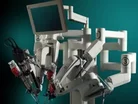Robot completes first bladder construction

By Matthew Staff
Ken Harries, 61 has thanked surgeons at Southmead Hospital in Bristol, UK after an operation back in October has given him a full bill of health once again, with minimal scars to show for it.
Mr Harries was diagnosed with Bladder cancer last May, and despite being offered the usual invasive surgery to remove the necessary damage, his confidence in his consultant, Dr Edward Rowe, persuaded him to opt for a previously untested procedure.
“I suppose I was a little bit shocked when they said I’d be the first but that soon disappeared and after discussions with the wife it was a very simple choice,” the father of two said.
“The only way I could look at the cancer was to say ‘I am going to beat this’, and I am so glad I decided to go through with the operation.”
+MORE HEALTHCARE GLOBAL
- Pregnancy could benefit breast cancer patients
- Fabrice Muamba highlights a risk for all footballers
- A new route to meeting patient needs and driving growth
The da Vinci robot was first used in 2008 to implement prostate removals, at the expense of £1.5 million. Since then, the device has carried out over 600 operations, aiding surgeons in cystectomys and nephrectomys which is the partial removal of kidneys.
This was the first of its kind involving work on the bladder however, with the procedure consisting of small incisions, and recreating the structure of the bladder by using some of Mr Harries’s own bowel tissue.
“Having removed the bladder containing the tumour, we reconstruct a new bladder from the patient’s own bowel and attach this internally to the patient’s urethra, allowing them to pass urine normally,” explained Dr Rowe, who navigated the robot from a nearby pod.
The major advantage of the da Vinci robot is its ability to carry out the operation at very small discomfort to the patient.
'Traditionally this is a major operation...but we hope that by using this minimal access route we can decrease the trauma to the patient, enabling them to obtain a faster recovery and return to normal activity,” Dr Rowe continued.
“Patients can be home from hospital following this type of surgery within four to seven days and in six to eight weeks they can return to a normal quality of life.”
And following his complete recovery and return to work within four months of his operation, Mr Harries is certainly likely to be recommending further procedures to be carried out by this medical gadget.
“When you consider what the team did...it sounds almost science-fiction, but now I feel as though nothing has changed.”
The Healthcare Global magazine is now available on the iPad. Click here to download it.
- Roche: Making Preventative Healthcare Accessible to AllMedical Devices & Pharma
- Manufacturers Unite in the Battle Against Breast CancerMedical Devices & Pharma
- Thirona’s AI Tech is Creating Individualised Patient CareTechnology & AI
- HPV Vaccine 'Protects Males from Cancers' - Global ReportMedical Devices & Pharma



